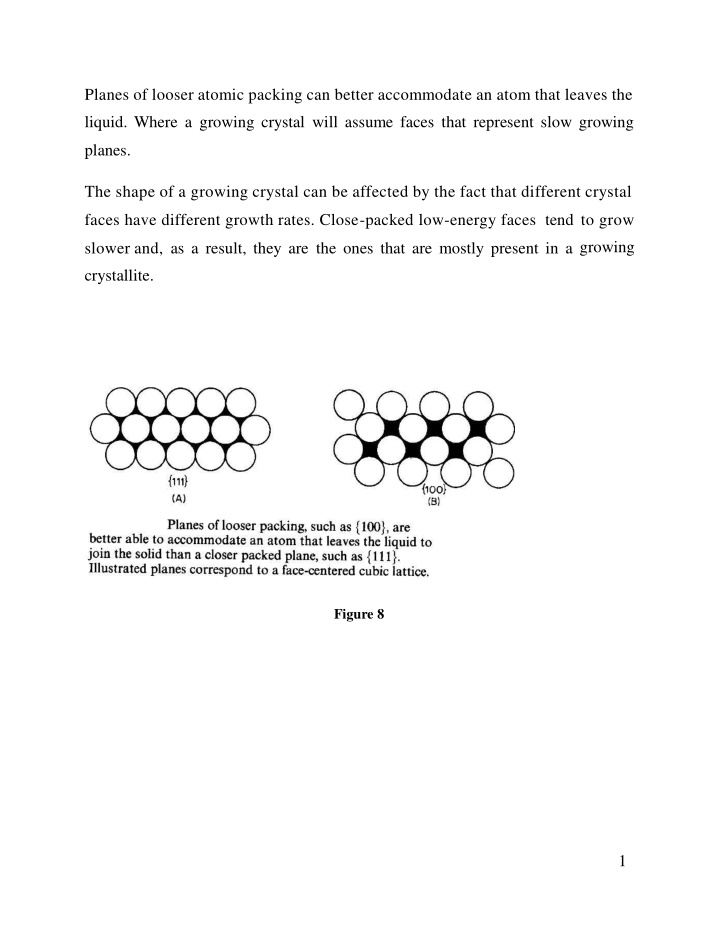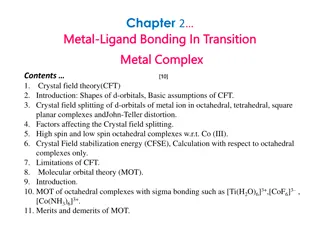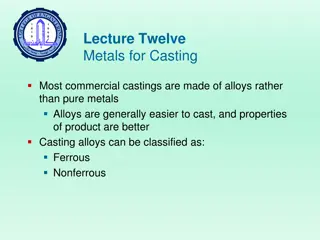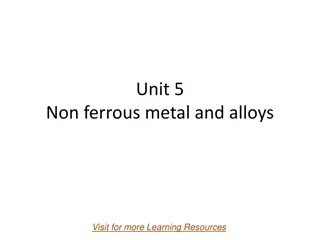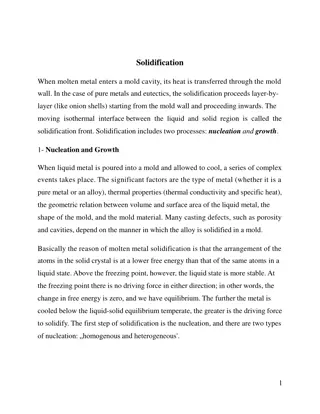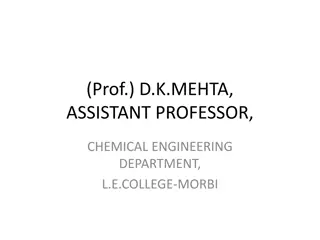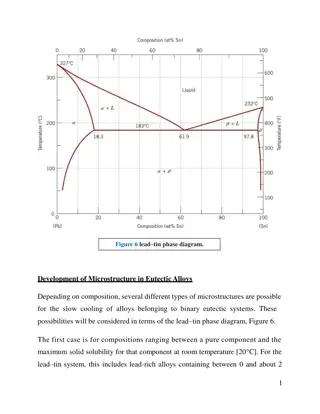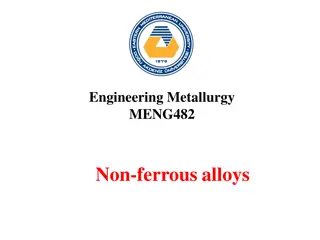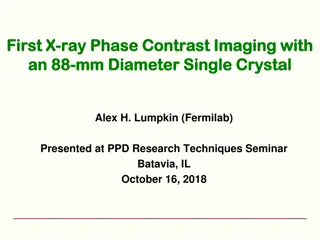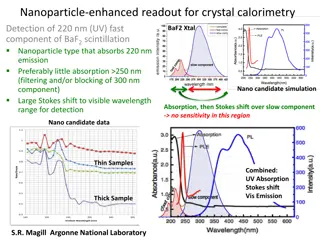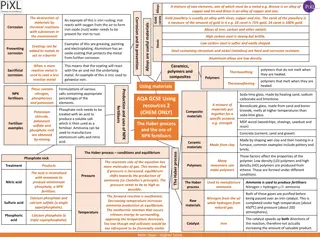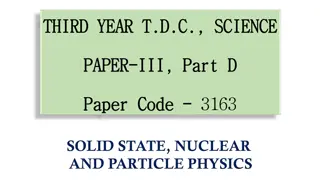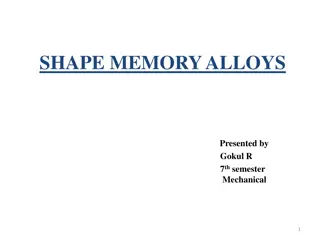Crystal Growth and Solidification in Engineering Alloys
Crystals in solidifying alloys exhibit different growth rates depending on the faces they assume, resulting in various grain structures in castings and ingots. Factors like nucleation, growth rates, and cooling conditions influence the final microstructure. Understanding these processes is crucial in material engineering.
Download Presentation

Please find below an Image/Link to download the presentation.
The content on the website is provided AS IS for your information and personal use only. It may not be sold, licensed, or shared on other websites without obtaining consent from the author.If you encounter any issues during the download, it is possible that the publisher has removed the file from their server.
You are allowed to download the files provided on this website for personal or commercial use, subject to the condition that they are used lawfully. All files are the property of their respective owners.
The content on the website is provided AS IS for your information and personal use only. It may not be sold, licensed, or shared on other websites without obtaining consent from the author.
E N D
Presentation Transcript
Planes of looser atomic packing can better accommodate an atom that leaves the liquid. Where a growing crystal will assume faces that represent slow growing planes. The shape of a growing crystal can be affected by the fact that different crystal faces have different growth rates. Close-packed low-energy faces tend to grow growing slower and, as a result, they are the ones that are mostly present in a crystallite. Figure 8 1
Figure 9 Total rate of a phase transformation induced by cooling is a product of the nucleation rate (driving force increases with undercooling but diffusion needed for atomic rearrangement slows down with T decrease) and growth rate (diffusion controlled - slows down with T decrease) Figure 10. At high T (close to Tm): low nucleation and high growth rates coarse microstructure with large grains. At low T (strong undercooling): high nucleation and low growth rates fine structure with small grains. 2
Grains Structure of Ingots and Castings Most engineering alloys begin by casting process. If the as-cast pieces are permitted to retain their shape afterwards, or are reshaped by machining, they are called castings. If they are later to be worked, e.g. by rolling, extrusion or forging, the pieces are called ingots. In either case the principles of solidification are the same. Generally speaking three different zones can be distinguished in solidified alloy ingots (Figure 11). These zones are (i) chill zone of equiaxed crystals, columnar zone of elongated grains, and (iii) a central equiaxed zone. (ii) a Figure 11 Chill Zone: During pouring the liquid in contact with the cold mould wall is rapidly cooled below the liquidus temperature. Many solid nuclei then form on the mould wall and begin to grow into the liquid, (Figure 12). As the mould wall warms up it is possible for many of these solidified crystals to break away from the wall under the 4
influence of the turbulent melt. If the pouring temperature is low the whole of the liquid will be rapidly cooled below the liquidus temperature and the crystals swept into the melt may be able to continue to grow. This is known as big-bang nucleation since the liquid is immediately filled with a myriad of crystals. This produces an entirely equiaxed ingot structure, i.e. no columnar zone forms, this also can be done by adding seeds or inoculants which are a solid small particles added to molten metal in the mold. If the pouring temperature is high, on the other hand, the liquid in the centre of the ingot will remain above the liquidus temperature for a long time and consequently the majority of crystals soon remelt after breaking away from the mould wall. Only those crystals remaining close to the wall will be able to grow to form the chill zone. Figure 12 Columnar Zone Very soon after pouring the temperature gradient at the mould walls decreases and the crystals in the chill zone grow dendritically in certain crystallographic directions, e.g. <100> in the case of cubic metals. Those crystals with a <100> 5
direction close to the direction of heat flow, i.e. perpendicular to the mould walls, grow fastest and are able to outgrow less favourably oriented neighbours (Figure 13). This leads to the formation of the columnar grains all with <100> almost parallel to the column axis. Note that each columnar crystal may contain primary dendrite arms (if it is an alloy).As the diameter of these grains increases additional primary dendrite arms appear by a mechanism in which some tertiary arms grow ahead of their neighbours as shown in the figure. Figure 13 Equiaxed Zone The equiaxed zone consists of equiaxed grains randomly oriented in the centre of the ingot.An important origin of these grains is thought to be melted-off dendrite side-arms. It can be seen that the side arms are narrowest at their roots. Therefore, if the temperature around the dendrite increases after it has formed, it will begin to melt and may become detached from the main stem. Provided the temperature falls again before the arm completely disappears it can then act as a seed for a new dendrite. An effective source of suitable temperature pulses is provided by the 6
turbulent convection currents in the liquid brought about by the temperature differences across the remaining melt. Convection currents also provide a means of carrying the melted-off arms away to where they can develop uninhibited into equiaxed dendrites. If convection is reduced, fewer seed crystals are created causing a larger final grain size and a greater preponderance of columnar grains. Shrinkage Effects Most metals shrink on solidification and this has important consequences for the final ingot structure. In pure metals, and also in narrow freezing range alloys (where the mushy zone is also narrow); as the outer shell of solid thickens the level of the remaining liquid continually decreases until finally when solidification is complete the ingot contains a deep central cavity or pipe. In alloys with a wide freezing range the mushy zone can occupy the whole of the ingot. In this case no central pipe is formed. Instead the liquid level gradually falls across the width of the ingot as liquid flows down to compensate for the shrinkage of the dendrites. However, as the inter-dendritic channels close up, this liquid flow is inhibited so that the last pools of liquid to solidify leave small voids or porosities. 7
Segregation in Ingots and Castings Two types of segregation can be distinguished in solidified structures. There is macrosegregation, i.e. composition changes over distances comparable to the size of the specimen, and there is microsegregation that occurs on the scale of the secondary dendrite arm spacing. There are four important factors that can lead to macrosegregation in ingots. These are: (i) shrinkage due to solidification and thermal contraction; (ii) density differences in the inter-dendritic liquid; (iii) density differences between the solid and liquid; and (iv) convection currents driven by temperature-induced density differences in the liquid. All of these factors can induce macrosegregation by causing mass flow over large distances during solidification. Shrinkage effects can give rise to what is known as inverse segregation. As the columnar dendrites thicken solute-rich liquid [assuming (partitioning constant) k < 1] must flow back between the dendrites to compensate for shrinkage and this raises the solute content of the outer parts of the ingot relative to the centre. The effect is particularly marked in alloys with a wide freezing range, e.g. Al Cu and Cu Sn alloys. Interdendritic liquid flow can also be induced by gravity effects. For example during the solidification of Al Cu alloys the copper rejected into the liquid raises its density and causes it to sink. The effect can be reinforced by convection currents driven by temperature differences in the ingot. Gravity effects can also be observed when equiaxed crystals are forming. The solid is usually denser than the liquid and sinks carrying with it less solute than the bulk composition (assuming k < 1). This can, therefore, lead to a region of negative segregation near the bottom of the ingot. 8
The combination of all the above effects can lead to complex patterns of macrosegregation. Figure 14 for example illustrates the segregation patterns found in large steel ingots. In general segregation is undesirable as it has marked deleterious effects on mechanical properties. The effects of microsegregation can be mitigated by subsequent homogenization heat treatment, but diffusion in the solid is far too slow to be able to remove macrosegregation which can only be combated by good control of the solidification process. Figure 14 9
